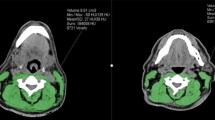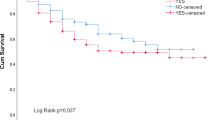Abstract
Purpose
Evidence suggests that patients’ skeletal muscle mass (SMM) can predict the patients at risk for cisplatin dose-limiting toxicities (DLT). Cisplatin is currently dosed on body surface area (BSA). The predictive value of SMM for cisplatin DLT in patients with locally advanced head and neck cancer (LA-HNC) is investigated.
Methods
Patients with LA-HNC treated with cisplatin-based chemoradiotherapy (CRT) were included. SMM was measured using pre-treatment scans. Logistic regression analysis was performed to identify the predictive impact of low SMM for DLT.
Results
In total, 343 patients were included of which 199 patients (58.0%) had low SMM and 154 patients (44.9%) experienced cisplatin DLT. In multivariate analysis, low SMM at diagnosis was the only predictive factor for DLT (HR 1.8, 95% CI 1.1–2.9).
Conclusions
Low SMM was associated with an increased risk of DLT. Trials are needed to investigate cisplatin dosing with consideration of SMM rather than solely BSA.


Similar content being viewed by others
Abbreviations
- LA-HNC:
-
Locally advanced head and neck cancer
- SMA:
-
Skeletal muscle area
- SMM:
-
Skeletal muscle mass
- LSMI:
-
Lumbar skeletal muscle index
- C3:
-
Third cervical vertebra
- L3:
-
Third lumbar vertebra
- HU:
-
Hounsfield unit
- LBM:
-
Lean body mass
- DLT:
-
Dose-limiting toxicity
References
Ferlay J, Colombet M, Soerjomataram I et al (2018) Cancer incidence and mortality patterns in Europe: estimates for 40 countries and 25 major cancers in 2018. Eur J Cancer 103:356–387. https://doi.org/10.1016/j.ejca.2018.07.005
Pressoir M, Desné S, Berchery D et al (2010) Prevalence, risk factors and clinical implications of malnutrition in french comprehensive cancer centres. Br J Cancer 102(6):966–971. https://doi.org/10.1038/sj.bjc.6605578
Elliott JA, Doyle SL, Murphy CF et al (2017) Sarcopenia: prevalence, and impact on operative and oncologic outcomes in the multimodal management of locally advanced esophageal cancer. Ann Surg 266(5):822–830. https://doi.org/10.1097/SLA.0000000000002398
Chargi N, Bril SI, Swartz JE, Wegner I, Willems SW, de Bree R (2020) Skeletal muscle mass is an imaging biomarker for decreased survival in patients with oropharyngeal squamous cell carcinoma. Oral Oncol. https://doi.org/10.1016/j.oraloncology.2019.104519
Ansari E, Chargi N, van Gemert JTM et al (2020) Low skeletal muscle mass is a strong predictive factor for surgical complications and a prognostic factor in oral cancer patients undergoing mandibular reconstruction with a free fibula flap. Oral Oncol 101:104530. https://doi.org/10.1016/j.oraloncology.2019.104530
Sawyer M, Ratain MJ (2001) Body surface area as a determinant of pharmacokinetics and drug dosing. Invest New Drugs 19(2):171–177. https://doi.org/10.1023/A:1010639201787
Astolfi L, Ghiselli S, Guaran V et al (2013) Correlation of adverse effects of cisplatin administration in patients affected by solid tumours: a retrospective evaluation. Oncol Rep 29(4):1285–1292. https://doi.org/10.3892/or.2013.2279
Wendrich AW, Swartz JE, Bril SI et al (2017) Low skeletal muscle mass is a predictive factor for chemotherapy dose-limiting toxicity in patients with locally advanced head and neck cancer. Oral Oncol 71:26–33. https://doi.org/10.1016/j.oraloncology.2017.05.012
Ali R, Baracos VE, Sawyer MB et al (2016) Lean body mass as an independent determinant of dose-limiting toxicity and neuropathy in patients with colon cancer treated with FOLFOX regimens. Cancer Med 5(4):607–616. https://doi.org/10.1002/cam4.621
Sjøblom B, Grønberg BH, Benth JŠ et al (2015) Low muscle mass is associated with chemotherapy-induced haematological toxicity in advanced non-small cell lung cancer. Lung Cancer 90(1):85–91. https://doi.org/10.1016/j.lungcan.2015.07.001
Kurk S, Peeters P, Stellato R et al (2019) Skeletal muscle mass loss and dose-limiting toxicities in metastatic colorectal cancer patients. J Cachexia Sarcopenia Muscle 10(4):803–813. https://doi.org/10.1002/jcsm.12436
Hopkins JJ, Sawyer MB (2017) A review of body composition and pharmacokinetics in oncology. Expert Rev Clin Pharmacol 10(9):947–956. https://doi.org/10.1080/17512433.2017.1347503
Hilmi M, Jouinot A, Burns R et al (2019) Body composition and sarcopenia: the next-generation of personalized oncology and pharmacology? Pharmacol Ther 196:135–159. https://doi.org/10.1016/j.pharmthera.2018.12.003
Mitsiopoulos N, Baumgartner RN, Heymsfield SB, et al (1998) Cadaver validation of skeletal muscle measurement by magnetic resonance imaging and computerized tomography. J Appl Physiol 85(1):115-122. https://doi.org/10.1152/jappl.1998.85.1.115
Chargi N, Ansari E, Huiskamp LFJ, Bol G, de Bree R (2019) Agreement between skeletal muscle mass measurements using computed tomography imaging and magnetic resonance imaging in head and neck cancer patients. Oral Oncol 99:104341. https://doi.org/10.1016/j.oraloncology.2019.06.022
Swartz JE, Pothen AJ, Wegner I et al (2016) Feasibility of using head and neck CT imaging to assess skeletal muscle mass in head and neck cancer patients. Oral Oncol 62:28–33. https://doi.org/10.1016/j.oraloncology.2016.09.006
Mourtzakis M, Prado CMM, Lieffers JR, Reiman T, McCargar LJ, Baracos VE (2008) A practical and precise approach to quantification of body composition in cancer patients using computed tomography images acquired during routine care. Appl Physiol Nutr Metab 33(5):997–1006. https://doi.org/10.1139/H08-075
Baumgartner RN, Koehler KM, Gallagher D et al (1998) Epidemiology of sarcopenia among the elderly in New Mexico. Am J Epidemiol 147(8):755–763. https://doi.org/10.1093/oxfordjournals.aje.a009520
Sealy MJ, Dechaphunkul T, Van Der Schans CP et al (2019) Low muscle mass is associated with early termination of chemotherapy related to toxicity in patients with head and neck cancer. Clin Nutr 39(2):501–509. https://doi.org/10.1016/j.clnu.2019.02.029
Dijksterhuis WPM, Pruijt MJ, van der Woude SO et al (2019) Association between body composition, survival, and toxicity in advanced esophagogastric cancer patients receiving palliative chemotherapy. J Cachexia Sarcopenia Muscle 10(1):199–206. https://doi.org/10.1002/jcsm.12371
Basile D, Corvaja C, Caccialanza R, Aprile G (2019) Sarcopenia: Looking to muscle mass to better manage pancreatic cancer patients. Curr Opin Support Palliat Care 13(4):279–285. https://doi.org/10.1097/SPC.0000000000000455
Pamoukdjian F, Bouillet T, Lévy V, Soussan M, Zelek L, Paillaud E (2018) Prevalence and predictive value of pre-therapeutic sarcopenia in cancer patients: a systematic review. Clin Nutr 37(4):1101–1113. https://doi.org/10.1016/j.clnu.2017.07.010
Prado CM, Lieffers JR, McCargar LJ et al (2008) Prevalence and clinical implications of sarcopenic obesity in patients with solid tumours of the respiratory and gastrointestinal tracts: a population-based study. Lancet Oncol 9(7):629–635. https://doi.org/10.1016/S1470-2045(08)70153-0
Morley JE, Baumgartner RN, Roubenoff R, Mayer J, Nair KS (2001) Sarcopenia. J Lab Clin Med 137(4):231–243. https://doi.org/10.1067/mlc.2001.113504
Funding
No financial support was received for this study.
Author information
Authors and Affiliations
Corresponding author
Ethics declarations
Conflict of interest
None of the authors have a conflict of interest.
Additional information
Publisher's Note
Springer Nature remains neutral with regard to jurisdictional claims in published maps and institutional affiliations.
Rights and permissions
About this article
Cite this article
Chargi, N., Bashiri, F., Wendrich, A.W. et al. Image-based analysis of skeletal muscle mass predicts cisplatin dose-limiting toxicity in patients with locally advanced head and neck cancer. Eur Arch Otorhinolaryngol 279, 3685–3694 (2022). https://doi.org/10.1007/s00405-021-07229-y
Received:
Accepted:
Published:
Issue Date:
DOI: https://doi.org/10.1007/s00405-021-07229-y




